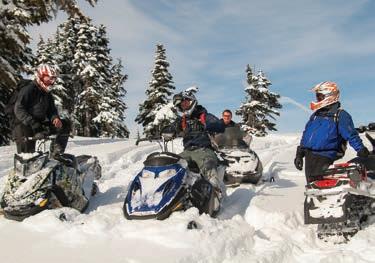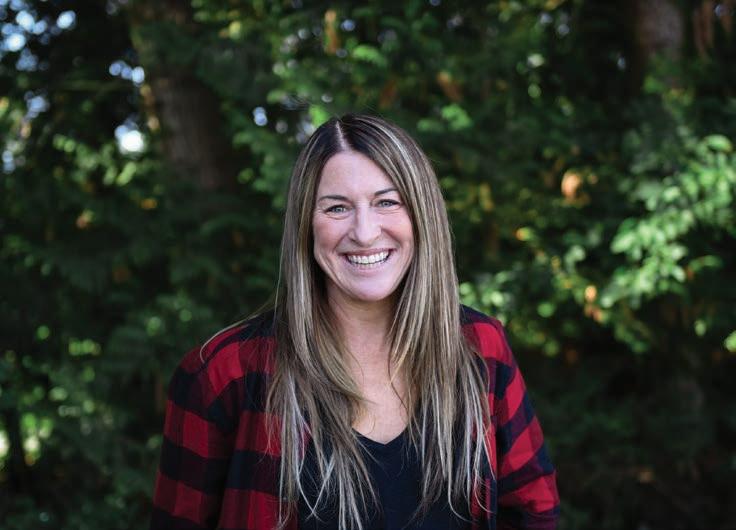
9 minute read
The path to the podium
By HALEY RITCHIE
IN SQUAMISH, AN OLYMPIC HOPEFUL LOOKS FORWARD TO THE WINTER GAMES, AND A RETIRED OLYMPIAN LOOKS BACK.
Advertisement
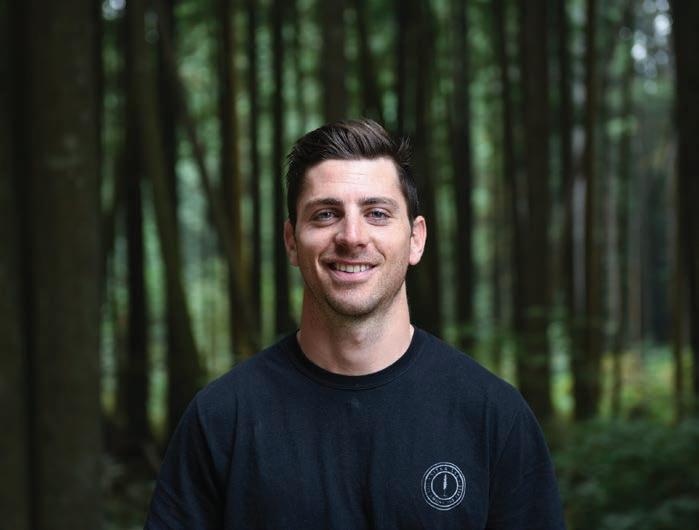
DARREN Gardner and Tami Bradley talk about what the next Winter Games in PyeongChang Korea means to them.
Gardner, 27 years old, is a snowboard racing Olympic hopeful. Gardner is from Burlington, and studies at Quest University in Squamish.
Gardner said he’s trying to keep the Olympics in perspective as an event, but he acknowledges that for a lot of athletes, the games are on a pedestal.
“The Olympics is definitely a different beast, from what I’ve heard. I just don’t have anything to compare it to right now,” he said.
The national champion snowboarder is hoping that will change this year if he can clinch a spot representing Canada in downhill snowboard at the 2018 Winter Games. The training is constant, but he’ll only know if he’s made that goal a few weeks before the games.
In 2014, he came short in the selection process.
“I wasn’t quite where I am today,” he said. “To be honest, it was the biggest learning experience for me. It sounds weird, but it was one of the best things to happen in my sporting year.”
“When 2014 didn’t really work out for me, I was kinda like, ‘What now?’ I knew I still really wanted to snowboard, but I also wanted to plan for a future after snowboarding. It was a very big wake-up call, in a lot of ways.”
As a snowboarder, Gardner’s sport is relatively new, and he’ll be competing for a spot with his fellow athletes in slopestyle, big air, halfpipe and snowboard cross. He says watching Ross Rebagliati winning gold in 1998 was a pivotal moment in his childhood.
Gardner said being a highlevel athlete means constantly reassessing goals, whether it’s World Cup events or the Olympics.
“You need to take the time to assess good or bad days … It’s super important. I think that’s been huge to my success, and my failure as well.”
above: Darren Gardner.
opposite page: Tami Bradley.
Photos: David Buzzard
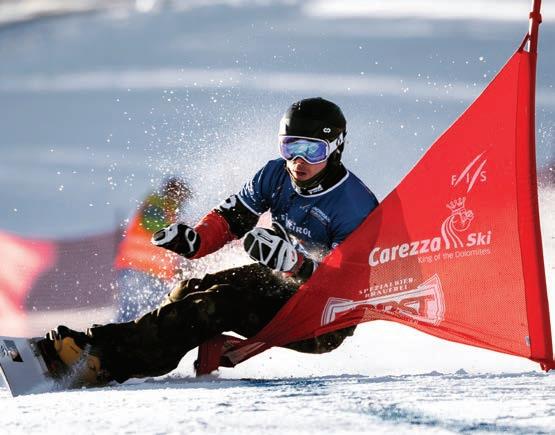
above: Darren Gardner at the FIS Snowboard World Cup, Carezza Italy. Photo: Miha Matavz
“For me, it’s year by year, it always has been,” he said. “I wouldn’t use the word hope. I feel if I keep doing what I’m doing, working hard throughout my events, things are going to work out. You can never say for sure, but I feel confident in what I’m doing to make it to that level.”
TAMI Bradley, 47 years old, made it to the Olympics twice for freestyle skiing moguls. Bradley is originally from North Vancouver and now coaches young athletes and lives in Squamish with her family.
“I think people think, ‘Oh the Olympics, they’re so great’,” says Bradley. “And it is. It is so great. But in the head of an athlete, you go through every different scenario.”
Bradley’s Olympic goal began at age five, watching gymnast Nadia Comăneci win gold on television. Watching the opening ceremonies was a family tradition.
“I can remember just waiting and watching for Team Canada to walk out,” she said.
Sixteen years later, Bradley was the one waving to fans through the television camera in Nagano, Japan. She said the feeling was “surreal.”
“This was my first Olympics not watching the opening ceremonies from my house. I wasn’t watching and waiting for Team Canada to come out: I was Team Canada.”
Bradley said in her first Olympics, she felt lucky to place in the finals. When she returned to Salt Lake City as a medal contender four years later, she had higher expectations.
In the end, Bradley didn’t meet her goal – crashing after her second air and placing 14th – and it left a scar that would take years to heal.
“Things didn’t go my way. In the scheme of sports, it was a devastating moment for me. In terms of life, was it devastating? No, but I was in shock. As much as I had made that decision, but I hadn’t played that possibility out.”
Bradley ended her professional freestyle skiing career in 2003, scoring two World Cup medals. By the next Winter Games, she felt like she had moved on from the Olympics and was busy discovering a new life: being a mom.
She was proud to see Canada do well in the 2006 women’s moguls, but after that single event she turned the TV off. It didn’t get switched on for the rest of the games.
“When I hung up the boots, I was content. But I think I felt such agony for athletes that were supposed to do well or could have done well.”
She expected the same feeling in 2010 when the games came home – Bradley and her husband decided to fly to Hawaii during the games to escape the hustle and bustle.
“It was odd, but we still weren’t over the craziness, the stress that we had felt from it. As enjoyable as it was as an athlete, there was another side of it, and I wasn’t ready for it in my hometown. But something happened when we were in Maui. Suddenly we were addicted to the TV. I was watching it and I was sad that we weren’t here. I felt the stress of not being a part of it.
If Whistler brought stress of a different kind, she said Sochi brought peace.
“Time heals, in a lot of different things,” said Bradley. “All of a sudden, I was at peace. The Olympics are over, I have a completely new life, I’m super happy and I can watch and enjoy it. Looking back at my Olympic experience, it was such a great thing. But during it, not getting the outcome you want, is definitely a challenge to heal from.”
“It took a long, long time to just watch and have that love back. Now I can’t wait to host all these Olympic parties in 2018.” •
OPEN WEEKENDS 1-5pm
39289 Falcon Cresent

Sledding in the Sea to Sky

By STEVEN HILL
IF you ask Tony Cailes his opinion about where Squamish ranks as a sledding destination, the president of the Black Tusk Snowmobile Club doesn’t exactly mince his words.
“This is the best place in the world to snowmobile,” he said. “And, that should be bolded and underlined!”
As evidence, he points to the sheer number of tourists who descend on the area every year to chew up fresh powder in the backcountry.
“People come from all over the world just to snowmobile here,” Cailes said. “And really, what sets us apart is the fantastic snow quality, the views and clarity, and the fact that our avalanche conditions are much more stable than in a place like Whistler, where they have ‘faster’ avalanches.”
Avalanche training is a big part of Black Tusk Snowmobile Club’s mandate. The association boasts close to 200 members and maintains the access road and chalet at arguably Squamish’s best sledding destination – Brohm Ridge. “We are the stewards of the snow, here,” he said. “For the past 45 years, we have worked to maintain Brohm Ridge, make it better for snowmobilers, and teach people about avalanche safety while sledding in the area’s backcountry.”
For Cailes, Brohm Ridge, once the proposed site for a ski resort in the 1960s (with a sweet 10,000 sq. ft., 50-person chalet they acquired as a clubhouse),
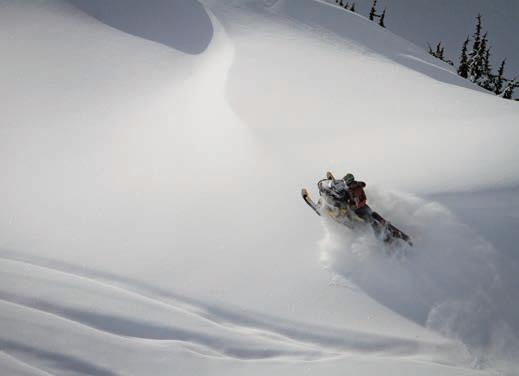
above: Sledding in Brohm Ridge. Photo: Brad Sarauer
right: Friends gather for an afternoon in the snow. Photo: Rich Duncan
opposite page: Photo: Rich Duncan is absolutely the ultimate snowmobile paradise in the Sea to Sky Corridor.
“Brohm Ridge is the safest place to drive a snowmobile, in terms of avalanche safety,” he said. “It is also the first place you can snowmobile in the area at the start of the season, and the last place you can snowmobile at the end of the year.”
The Squamish snowmobile season starts at the end of November and can last until June if it’s been a particularly good snow year. In the spring, it is not uncommon to spend the morning snowmobiling and then play a round of golf in the afternoon afterward.
“Other spots melt out, or you have to ride on a gravel road for way too long before you hit snow,” he said. “Plus, Brohm Ridge is a great place for an intro to snowmobiling in the area, no matter your level, and you can always make arrangements to stay in the chalet overnight, which is always a treat for people.”
However, the fate of Cailes’s favourite Squamish sledding spot may be in question, as the idea of developing a ski resort in the area has resurfaced in recent years, under the name “Garibaldi at Squamish.”
But, he said he thinks there is room for everyone on Brohm Ridge, as well as all of the Sea to Sky’s backcountry.
“I think the best thing would be a co-existence,” Cailes said. “I’ve spent a lot of time on that mountain. I’ve snowmobiled it. I’ve skied the whole thing. It’s really not a practical place to ski. I think something they should look at is reducing the footprint of the ski resort, and putting it in a more stable and practical area of the mountain. Make the top of the mountain a shared ‘mountain sports centre.’ It’s the same with any developments that may come along. We can all live together and share the backcountry. It’s the safe and practical thing to do.”
And, Brohm Ridge is not the sole spot in the Squamish area that’s a sledding paradise, either. Just a little further north along the Sea to Sky Highway, the Brandywine area comes in at a close second for snowmobiling, according to Cailes.
“Brandywine is excellent because of the parking and the road,” he said. “You can practically just drive in, park, unload your sled, and away you go. And it continues to improve over the years, too.”
He also said the Lillooet/ Goldbridge area, north of Whistler Resort, is another breathtaking place to ride a snowmobile, although he classifies it as more “traillike” than the deep and sweet backcountry powder you’d be roaring through on Brohm Ridge or at Brandywine.
“Really, to enjoy the experience here, you have to be prepared for the conditions in which you’ll be riding,” he said. “An Ontario trail sled isn’t practical around Squamish. Everyone here drives the ‘Porsches’ of snowmobiles. And, you really need to have avalanche gear and some avalanche training. Then you can just have fun and enjoy the experience.” •
